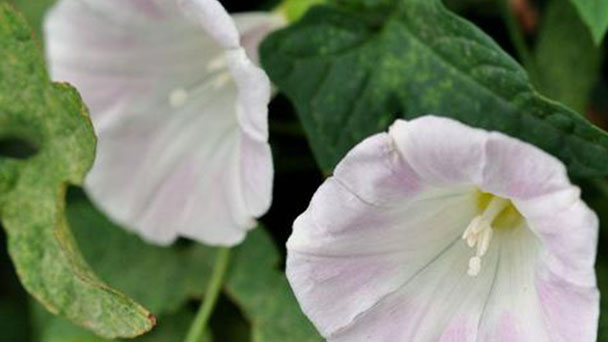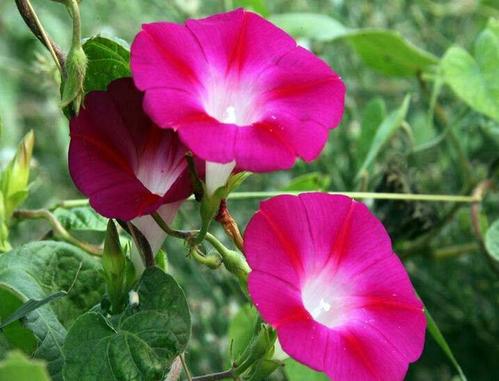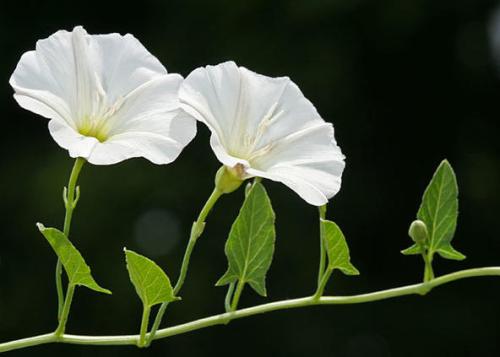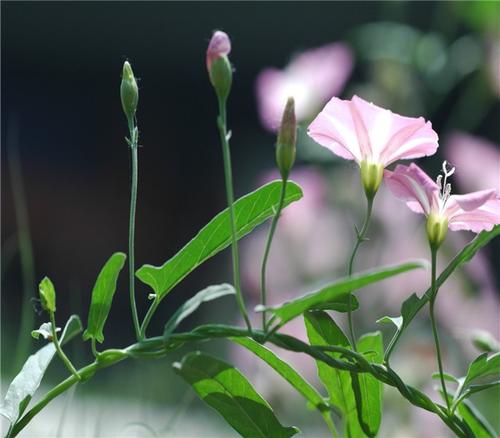Calystegia (false bindweed) profile
Written by Maggie
Mar 31 2021

Calystegia, also known as bindweed, false bindweed, or morning glory, is convolvulaceae. Calystegia is a perennial herb similar to but not identical to the morning glory. It can be used as medicine and has the effect of invigorating spleen, promoting digestion and relieving pain. But Calystegia has certain toxicities, be careful to eat. It can also be used as garden plants.
Calystegia picture

Calystegia ranges from Ethiopia in East Africa to southern and eastern Asia to Malaya.
Morphological characteristics of Calystegia
Stems
Calystegia is a perennial herbaceous vine without hairs, usually stunted, often branched from the base, with slender white roots.Stem thin, prostrate, slender.
Leaf
Leaf blade of Calystegia base is oblong, apically rounded, base halbiform, upper leaf blade 3-lobed, middle lobed oblong or oblong-lanceolate, lateral lobes sub triangular, leaf base cordate or halbiform.
Flowers
Flowers of Calystegia are axillary, pedicels longer than petiole, bracts broadly ovate; Sepals are oblong, tip obtuse, mucronate, inner sepals slightly shorter; Corolla is lavender or reddish, campanulate, eaves sub truncate or lobed; Stamens are subequal, filaments enlarged at base, adnate at base of corolla tube, covered with small scales; Ovarian is glabrous, stigmas 2-lobed, lobes oblong, flat.
Fruit
Capsule of Calystegia is ovoid, persistent sepals subequal or slightly shorter.Seeds black brown, the surface has verruca.
Ecological habits of Calystegia
Calystegia prefers mild and humid climates, but is also tolerant of harsh environments and is adapted to sandy soils. Calystegia occurs in coastal areas as a dominant or companion species to sandy, gritty, or gravelly soils, sometimes in single communities on gravel soils of granite, gneiss, or schist near the coast, especially on hillsides where sea spray is common. It is an indicator plant for saline-alkali soil in coastal areas of China with moderate climate.
How Calystegia propagates
Propagation of roots, buds and seeds
In the field, asexual propagation is the main one. The underground stem is brittle and easy to be broken, and new plants can grow from each broken body with nodes. Seedling emerges in spring in North China, flowering in summer, and fruiting from in autumn. The seedlings appear in spring in the Yangtze River Basin, and the flowering period is in spring.

The distribution region of Calystegia
Calystegia is distributed throughout the country; Calystegia is distributed throughout Ethiopia, Asia, Malaya and mainland China.
Calystegia is suitable for moist and fertile soil, but also tolerant of barren, drought. Because of the rapid spread of underground stems, they often form single dominant communities, which do serious harm to farmland and become malignant weeds in some areas. It mainly harms spring wheat, cotton, beans, sweet potatoes, corn, vegetables and fruit trees, especially wheat. Calystegia not only directly affects the growth of wheat, but also leads to lodging of wheat and hinders mechanical harvesting.It is the host of the baby ground tiger.
Plant hazards of Calystegia
Damage reason
Because of the rapid spread of underground stems, Calystegia often forms single dominant communities, which do serious harm to farmland and become malignant weeds in some areas. It mainly harms spring wheat, cotton, beans, sweet potatoes, corn, vegetables and fruit trees, especially wheat. Calystegia not only directly affects the growth of wheat, but also leads to lodging of wheat, which hinders mechanical harvesting. It is the host of small ground tiger.
Chemical control
In the wheat field, herbicides such as green melon, Liguolong, 2 methyl 4 chlorine, Baicaodi, Pai cao Dan, and giant star should be used. Bean field application of Saike, Guangmiling, Pusst, Huwei, weed burning and other herbicides; You should kill the Calystegia in the corn field.
Calystegia uses
Edible value
Each hundred grams of tender stems and leaves of Calystegia contains 81 grams of water, 0.5 grams of fat, 5 grams of carbohydrates, and 422 milligrams of calcium, phosphorous 40 milligram, iron 10.1 milligram, carotene 5.28 milligram, vitamin B10.02 milligram, vitamin B20.59 milligram, Nike acid 2 milligram, vitamin C54 milligram.Roots contain 17% starch, edible and medicinal, but poisonous, should not be eaten.
Medical use
Calystegia can treat spleen weakness and deficiency of qi in children: root of the vine root, chicken excrement vine to make cake clothes.
Calystegia can treat kidney deficiency and deafness: fresh root rattan root, bell grass 42. Stewed pig ear suit.

Latest Updated
- Benefits of Bugleweed - 7 Science-backed Health Benefits
- Bugleweed Dangers & Side Effects - Is It Poisonous?
- How to Plant Evergreen Trees - What You Should Know
- When to Plant Evergreens - Grow Guide for Evergreen Trees
- 12 Wonderful Evergreen Shrubs for Your Garden
- 12 Popular Evergreen Plants with Pictures for Beginners
- When And How To Prune A Lilac Bush Like a Pro
- How to Grow & Care for Lilac Vine (Hardenbergia Violacea)
- Japanese Lilac Tree (Syringa Reticulata) Care & Propagation Guide
- Shumard Oak Pros and Cons - What to Know
Popular Articles
- Winter maintenance of Antirrhinum Majus
- How to Grow Terminalia Mantaly Tree
- How to Grow and Care for Crossostephium Chinense
- How to grow Antirrhinum Majus in spring
- Peristeria Elata (Dove Orchid) Profile: Info & Care Guide
- Underwatered Snake Plant (Sansevieria Trifasciata) - Signs And How To Fix
- How to Care for Brazilian Jasmine Plant (Mandevilla Sanderi)
- How to Grow & Care for Graptopetalum Purple Delight in Summer
- Rosa Chinensis (China Rose): Plant Growing & Care Tips
- How to Care for Baby Sun Rose (Aptenia Cordifolia)